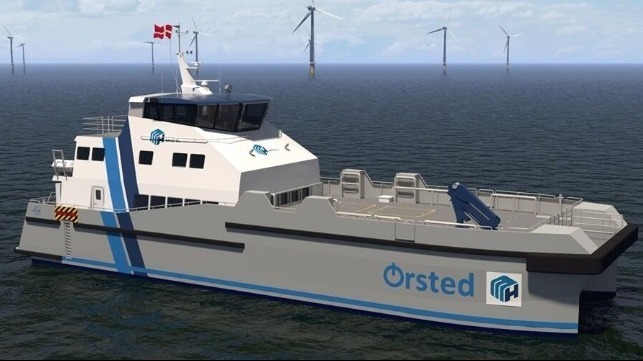Volvo Penta Uses Pilot Tech in One of the UK’s First Hybrid CTV's

[By: Volvo Penta]
In close collaboration with electrification experts, Danfoss Editron, Volvo Penta is powering two hybrid vessels using pilot technology. Set to be launched in summer 2021 these vessels are an innovative combination of integrated electric Volvo Penta Inboard Performance Systems (IPS), state-of-the-art gensets, and advanced vessel management systems.
In spring 2020 the Volvo Penta team took on a new and exciting pilot project for longtime customer and Volvo Penta Inboard Performance System (IPS) user, MHO&Co. This Danish operator’s mission was to create two hybrid crew transfer vessels (CTVs) for operator Ørsted – one of the world’s biggest wind farm operators. Combining the best-in-class propulsion – Volvo Penta IPS – and Danfoss Editron’s expertise in marine electrification systems and in-house designed electric propulsion motors and generators, the companies are working on creating an advanced hybrid solution that has maximum uptime, efficiency, and maneuverability.
“At Volvo Penta, we are always striving for innovative and sustainable solutions to customers’ challenges,” says Peter Granqvist, Chief Technology Officer, Volvo Penta. “One of the best ways to advance our technology is to take on these bold projects and work collaboratively with other technology leaders. This project is teaching us a lot about experimental technical solutions, and we are excited to see the outcomes and learn more. As a pilot project, this system is not immediately for sale.”
The 35-m (82-ft) CTVs – designed by MHO&Co in cooperation with Incat Crowther in the UK and Australia and built by Afai Southern Shipyard in China – is a global collaboration. Both vessels will be capable of carrying 24 crew and fitted with a large lounge area and eight cabins. The CTVs will serve Ørsted’s Hornsea Two offshore wind farm, which will be from 56 Nm (89 km) to 65 Nm (120 km) off the Yorkshire coast in the North Sea. We expect it to enter operation in 2021.
Gensets
Volvo Penta marine gensets will help power these vessels – the electric propulsion power for the driveline will come from five variable speed Volvo D8 gensets. The use of variable speed gensets combined with the selectable multi-genset option has major environmental advantages and will ensure high availability resulting in extremely low downtime. Additionally, the smaller D8 units allow for future technologies by replacing one (or more) D8 with fuel-cells or similar when technology allows.
Electric IPS: a unique hybrid system
Volvo Penta IPS is already a revolutionary technology in the marine industry, but now the company is driving that technology forward into a new chapter – electric IPS. Building on the trusted innovation, Volvo Penta has worked closely with Danfoss Editron to create the breakthrough serial hybrid system. The system consists of Volvo Penta IPS QUAD set-up, where two of the four legs are powered by Volvo Penta D13 diesel propulsion engines and two legs are powered by Danfoss Editron’s electric machines, which are in turn powered by five Volvo Penta D8 variable speed gensets. Additionally, a battery pack will be installed to support peak-shaving and to allow the vessels to operate in fully electric mode at low speed, and during long stationary periods.
Erno Tenhunen, Marine Director, Danfoss Editron said: “This project will open the market for more hybrid CTVs. Previously, the size of electric motors and components were too big for CTVs. Our compact and lightweight technology has overcome this issue and solved the challenges faced by vessel designers, shipyards, and end customers. Our system, in combination with Volvo Penta’s compact drivelines and gensets, makes installation easy, even in a limited space. Plus it allows flexibility on system concepts and machinery room design.”
Both CTVs will be capable of operating in either fully electric or hybrid mode. When cruising to windfarms all four Volvo Penta IPS can be powered, two mechanically and two electrically. In harbor or at the wind farm there is the option to run the vessels with either battery to the electrical Volvo Penta IPS legs or any combination of 1-5 gensets, depending on weather conditions. It is estimated that this choice of operation is set to save about 127 metric tons of CO2 compared to traditional diesel-powered vessels.
Inteligent communication
From the bridge, these vessels act as a Volvo Penta IPS QUAD with hybrid options, assisted by the Danfoss Editron Control System (ECS). The vessels are commanded by Volvo Penta controls and the EVC system (Electronic Vessel Control System), which communicates to the D8 gensets as well as the Danfoss Editron ECS. The ECS calls off genset power and/or battery power automatically, or when ordered from the captain's HMI-display.
“Our many years of working in the offshore wind industry, coupled with Incat Crowther’s expertise, have brought the design of these vessels to life,” says Mik Henriksen, founder of MHO&Co. “However, the technological developments behind these vessels have been a learning process for all involved. As a company we have been a longtime user of Volvo Penta IPS – and have always been fans of the superior propulsion, thrust, and maneuverability of the system. To be able to take this trusted technology to the next level and go electric is a big win for us in terms of future opportunities.”
The products and services herein described in this press release are not endorsed by The Maritime Executive.
